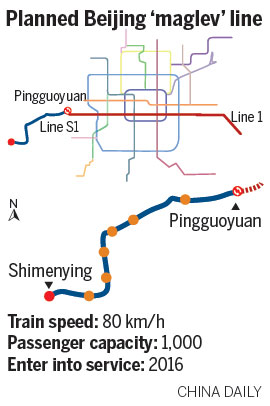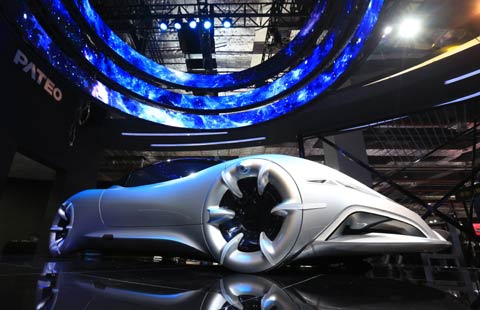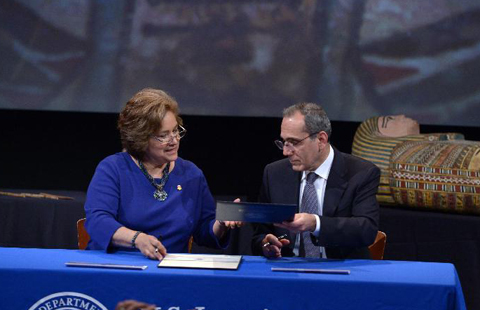New public transit line taps cheaper, quieter technology
Updated: 2015-04-22 07:41
By Zhao Lei(China Daily)
|
|||||||||
Construction has started on a new public transportation line in Beijing that promises to be cheaper to build and run - and less noisy - than subways.
The city is building its first "maglev" line, short for magnetic levitation, a cutting-edge technology in rail transit. The line will have a top train speed of 80 km/h. It is expected to become operational before the end of next year.
Work on the 10-km Line S1, which will run through two of Beijing's western districts, Mentougou and Shijingshan, started on Monday, according to the project's contractor, CREC 6th Engineering Group's Beijing Railway Construction Co.
The line will have eight stations and will run mostly along elevated tracks. Once it is completed, passengers riding the train will be able to transfer to the Line 1 and Line 6 subways.

A prototype of the line's maglev train has been produced and will be tested, Beijing Enterprises Group's Maglev Technology Development Co told Beijing Times, noting that the train has six cars and is capable of carrying more than 1,000 passengers.
Experts believe the maglev line will offer huge potential for public transport in megacities because of the cheaper cost and reduced noise.
The S1 line was proposed and planned in 2009, and some preparatory work began in early 2011, but it was suspended after residents expressed concerns over the environmental impact and electromagnetic radiation.
The city government approved the project in October 2013 after experiments and tests showed the line posed no health or environmental risks.
Less impact
"If you stand 10 meters away from the line, the electromagnetic impact on your body will be even less than that caused by your television or refrigerator," said Gong Guilin, the line's chief engineer at Beijing Railway Construction. "In addition, the line will have little noise because the train will be running above the tracks without any friction."
Shanghai, China's financial hub, is the only Chinese city that now operates a commercial maglev line. The 30-km high-speed maglev line using German technology began running in early 2003, with a maximum operational speed of 430 km/h.
The other two operational maglev lines are also in Asia - the Aichi High-Speed Transit Tobu Kyuryo Line in Japan and the Incheon Airport Maglev in South Korea.
zhaolei@chinadaily.com.cn

 Ten photos you don't wanna miss - April 23
Ten photos you don't wanna miss - April 23
 Concept cars in spotlight at Shanghai auto show
Concept cars in spotlight at Shanghai auto show Volcano erupts in southern Chile, belching ash, smoke into sky
Volcano erupts in southern Chile, belching ash, smoke into sky
 US returns ancient artifacts to Egypt
US returns ancient artifacts to Egypt
 Unusual libraries around the world
Unusual libraries around the world
 Chinese real estate deals in US topical forum
Chinese real estate deals in US topical forum
 Weird stuff you can buy on Taobao
Weird stuff you can buy on Taobao
 Top 5 wealthiest women in world's tech sector
Top 5 wealthiest women in world's tech sector
Most Viewed
Editor's Picks

|

|

|

|

|

|
Today's Top News
Nuclear cooperation proposal lauded
Furious 7 on track to be tops in China
As PayPal split looms, eBay plans to think small
China loves almonds from water-thirsty California
China sustains US cities: Bloomberg
Real estate investors may switch focus: panel
Obama submits nuclear energy cooperation deal with China
US urges Japan to handle wartime history in constructive way
US Weekly

|

|







